Unit History of the
220th Aviation Company—1965 Overview:
Updated August 20, 2012
In the beginning:
On 15 March 1965 the unit was constituted in the Regular Army as the 220th Aviation Company and on 31 March 1965 it was activated at Fort Lewis, Washington. Then on 15 April 1965 it was organized as the 220th Aviation Company (Surveillance Airplane Light). On 15 May 1965 the first personnel arrived and the first Morning Report was submitted. No TO&E was published for the unit; instead, paragraphs from three existing TO&Es, 1-7D, 1-59D and 55-500R, were used with some additions and deletions from each. Major Jerry Ralph Curry was the first Company Commander. As the 220th grew into being, the 231st Signal Detachment (Avionics Repair) was also formed at Fort Lewis and attached to the 220th Aviation Company (SAL) for deployment to Vietnam. 2nd Lt Robert P. Covino was the first Detachment Commander.
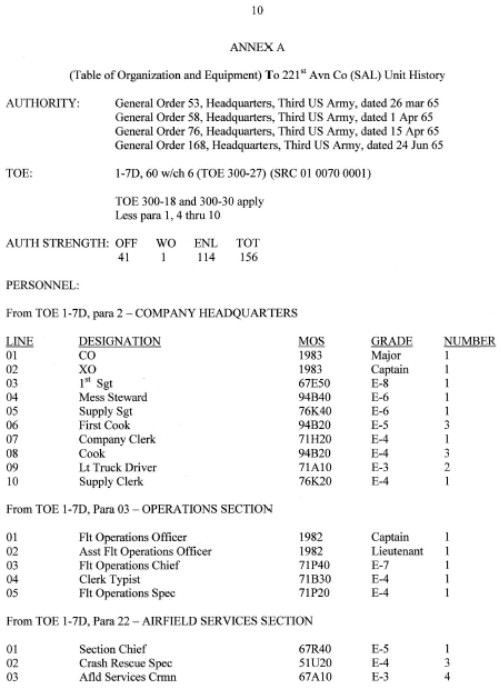
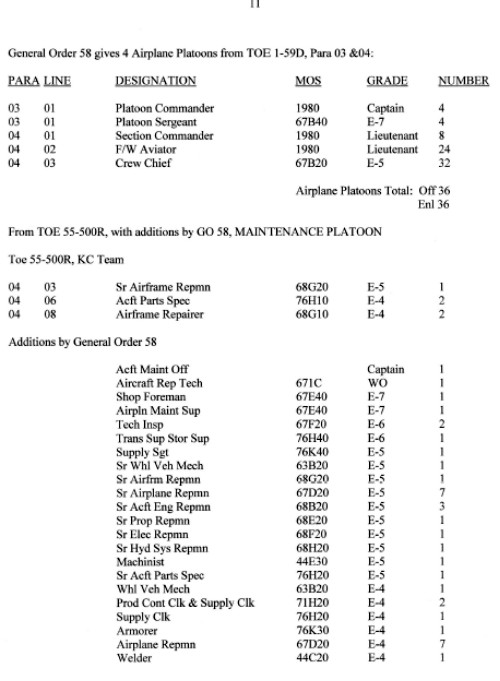
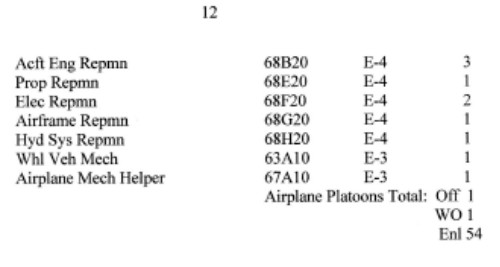
NOTE: The initial TO&E for the 220th could not be found, so we borrowed the one from the 221st. The 219th, 220th and 221st were all formed up and deployed at essentially the same time using the same basic TO&E 1-7D with modifications. I am not sure where the 219th was born, but the 221st was activated at Fort Bragg-Third US Army. Our Fort Lewis address put us in Sixth US Army.
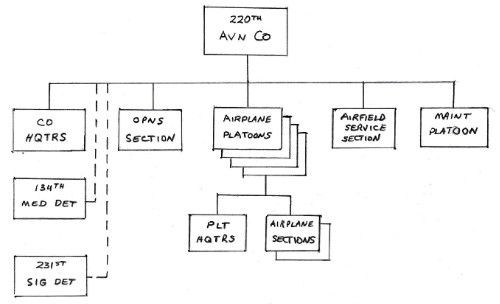
Equipment, less aircraft (which would be picked up in Vietnam), was drawn, packed and delivered to the dock in Tacoma on 10 June 1965 while the personnel were undergoing a vigorous POR qualification program to include rigorous physical training. On 19 June an advanced party of seven officers and nine enlisted men led by the unit commander, Major Curry, departed for Vietnam. The other six officers included the Operations Officer, Captain Richard "Dick" Quigley, who had already served a tour in Vietnam, CWO Donovon "Don" Behney, the Aircraft Maintenance Technician, and the four Platoon Leaders, Captains William "Bill" Everett, David "Dave" Rogers, Robert "Bob" Chancellor, and John Jones. The enlisted men included Command Sergeant Major Carol Simpson, Sergeant Pablo Sandoval, the Mess Sergeant, and a select group of men to assemble aircraft and accomplish other necessary tasks. They arrived in Saigon on 26 June and it was then that they learned of the unit assignment to support the US III Marine Amphibious Force in the northernmost I Corps Tactical Zone area of operations. On 30 June, upon completing most of its work in Saigon, except for a stay-behind party to collect loose ends and assemble the remainder of the airplanes, with five airplanes the initial pioneer team of the 220th Aviation Company was on its way to Hue-Phu Bai, the new home of the 220th in the Republic of Vietnam. Captain Rogers was able to borrow a U-1 "Otter" from an former Army acquaintance and made multiple trips between Saigon and Phu Bai hauling equipment and building materials that had been shipped to Saigon from Fort Lewis, and as well, items that had been acquired from the Saigon area:
The select enlisted soldier team members of the 220th Advance Party to Vietnam were, their names taken from the transcribed movement orders that follow:
Craig, James A.
Fajerson, Gustof O.
Gribble, Everett G.
Hollingsworth, James W.
Kucinskas, Helmut W.
Lacro, Antonio
Rozgowski, Richard F.
Sandoval, Pablo (Chief Cook and Scrounger - according to then MAJ Curry)
Sheets, James D. (231st Signal Detachment)
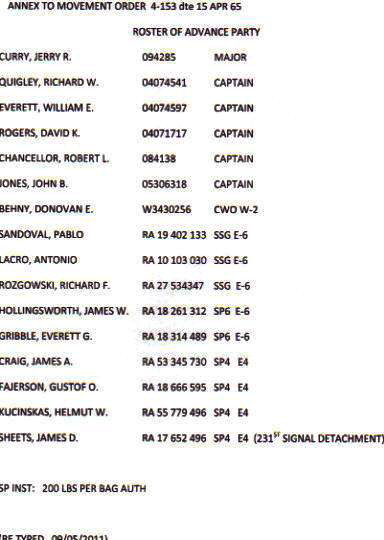
The main body of the company, led by the Executive Officer, Captain William O. "Bill" Schmale, closed out at Fort Lewis and departed McChord Air Force Base on 1 July 1965. The first of three C-130 aircraft closed at Da Nang (Main) AFB on 4 July, with the third on 6 July. The first operational surveillance mission was flown on 5 July as all hands that were available, officers and enlisted alike, set about filling sand bags, installing a triple concertina fence and building necessary facilities on the barren sand pile that was to be the home of the 220th for the unknown future.
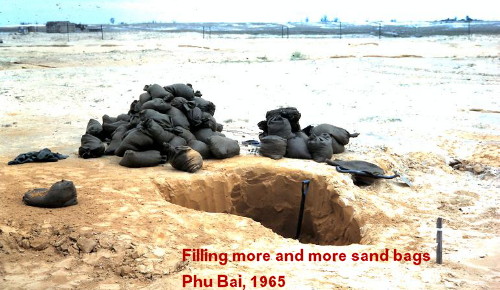
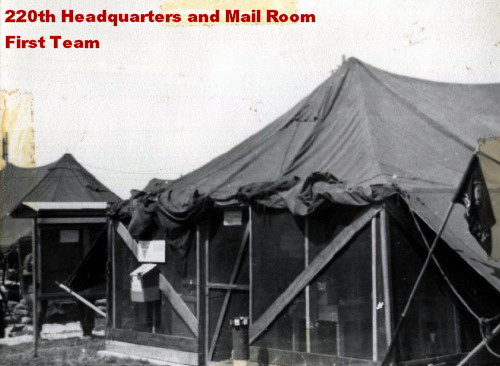
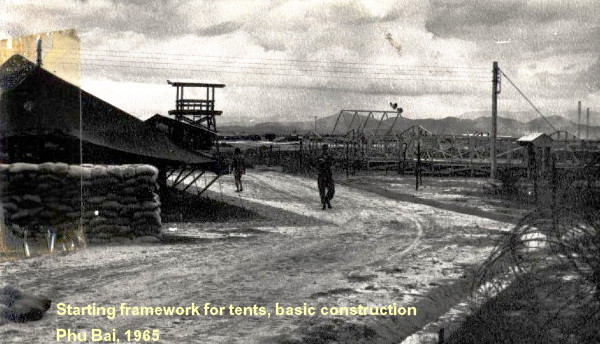
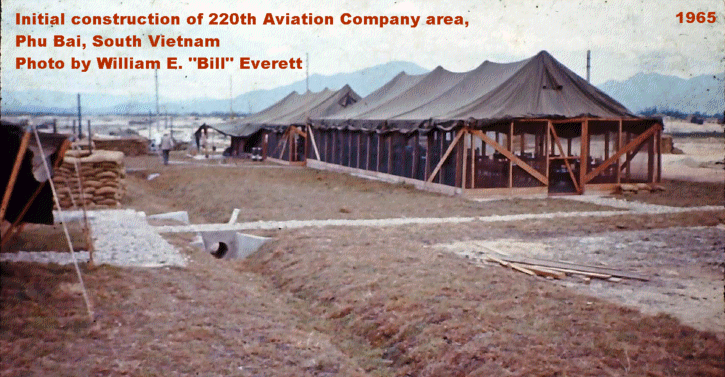
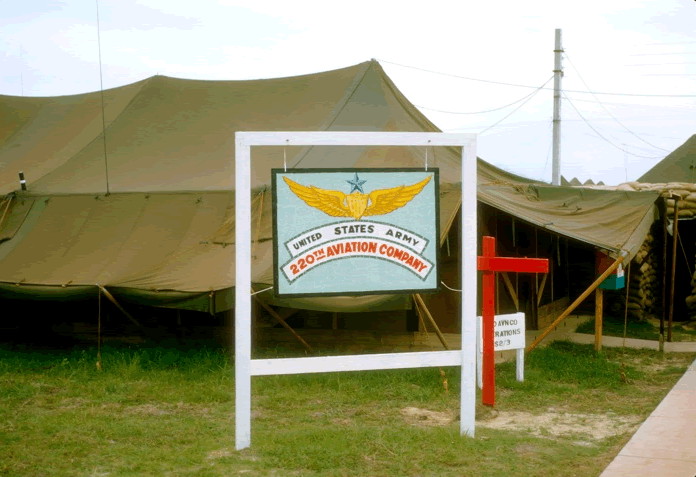
After completion of the the area construction. Grass!
See more of Dewey´s photos at the History Index for 1965.
Early on (not necessarily in this order) the men of the 220th recognized the requirement for an "identity" and we are told by Dewey Grocox that the 220th "WE OBSERVE" patch was designed by Gustof Fagerson on an engine crate. The Saint Andrew´s White Cross background came from Major Curry´s family crest — and after final approval by Major Curry, the first patches were made up in a sewing shop in Hue. On 7 July, Captain Bill Schmale, the XO and Unit Historian, documented that Captain Richard "Dick" Quigley, the Operations Officer, came up with the radio call sign "CATKILLERS" which became the nickname for the unit which was used from that time on throughout I Corps to denote the 220th. Getting the word directly "from the horse´s mouth", Dick Quigley, who responded to a telephone call "in the blind" in February 2011, the "story" goes like this (not verbatim): "Upon departing Saigon I was the flight leader for four Birddogs up the coast on a Sunday morning on our way to Phu Bai . After a refueling stop we had departed Nha Trang and as we were approaching Da Nang, I called Da Nang control as ‘Army — Tail Number’ requesting permission for a flight of four to pass to pass through your area from south to north enroute to Phu Bai. The controller asked, ‘What is your call sign?’ I (Dick) replied, ‘Call sign? We don’t have one.’ The controller responded, ‘Every unit in Vietnam has a call sign.’ So, on the spot, I said, ‘We are four Birddogs; birddogs kill cats; so why not call us Catkillers? This is Catkiller — Tail Number with a flight of four...quot; To end this story — that is exactly how it began — and it stuck."NOTE: We will see that between that date and the stand-down of the 220th, there was a variation of the call sign and nickname in spelling, CATKILLER and/or CAT KILLER. However, the meaning and sound of "it" was always the personal identification of the unit and its personnel in the 220th Aviation Company of I Corps.
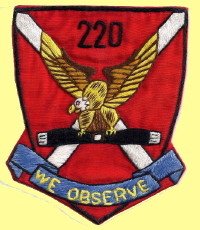
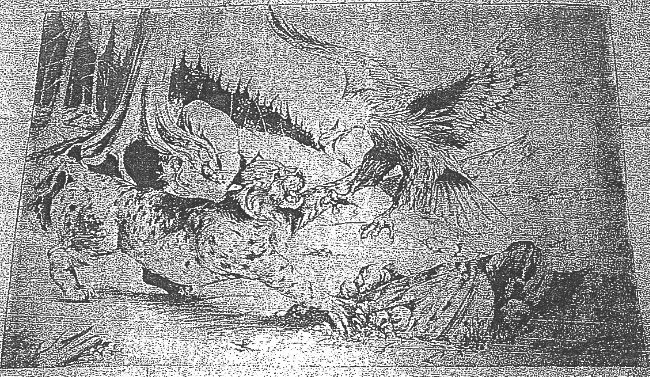
Photo/Sketch from the 220th Files in the National Archives showing an Eagle, from the unit patch, attacking a Cat, a Tiger, which might appear to denote the enemy as seen by other animals in Vietnam — original source unknown.
With the mission of being up to speed and assuming fully operational status on 1 August, the company commander, Major Curry, determined that the I Corps Tactical Zone with three major headquarters therein, would lend itself perfectly to a three platoon operation. The unit had already been directed by MACV to detach and dispatch its fourth flight platoon to Saigon, where it was infused with the 74th Aviation Company to break up and cross level the DEROS pattern and eventually became the 5th Platoon of the new 219th Aviation Company in II Corps. On 10 July, the 1st Platoon, [8 O-1F aircraft, 9 officers (1 Platoon Leader, 2 Section Leaders and 6 Aviators) and 9 enlisted men (1 Platoon Sergeant and 8 crew chiefs) made up each platoon], led by Captain Everett, was assigned to Quang Ngai in support of the ARVN 2nd Infantry Division and the USMC enclave at Chu Lai, then the 1st Marine Aircraft Wing. The 2nd Platoon, led by Captain Rogers, was assigned to the Citadel Airfield in Hue in support of the ARVN 1st Infantry Division and the USMC enclave at Phu Bai, then the 3rd Marine Division (Fwd). The 3rd Platoon, led by Captain Chancellor, was assigned to Da Nang (Main) Air Force Base in support of the ARVN I Corps Headquarters, the USMC enclave, then the HQ 3rd Marine Division and HQ III Marine Amphibious Force at Da Nang, the Quang Nam Special Sector and the US Special Forces camps scattered camps throughout I Corps. Among the ARVN units there were also numerous US Army Advisory personnel.
As no previous procedure had been set up by Headquarters I Corps for the employment of the 220th, each sector and regiment expressed the desire to have its own aircraft located and maintained at its own outlying strip. However, through the foresight of Major Curry and his entire headquarters staff, rather than set themselves up for poor unit cohesiveness, administration, the inability to properly maintain the aircraft and an inevitable sense of failure to properly support the totality of the mission that the company had been given, Major Curry insisted that the platoons remain in tact and be given mission type tasking that could be properly handled. In a very short time, each platoon proved itself equal to all assigned mission tasking and the entire unit performed admirably and quickly established itself in its new combat environment.
While unit equipment and much needed items of supply and repair parts that had been shipped from Fort Lewis arrived in Saigon on 3 July, the first vehicle and load did not arrive in Phu Bai until 26 July. The first CONEX containers arrived three days later. There was still much to learn about being several miles north of the end of the Army supply line. At that time, the next higher Army Headquarters was the 14th Aviation Battalion, then in Nha Trang over 300 miles away, part of the US Army Aviation Group in Saigon. As new Army Aviation units were introduced into Vietnam, the 14th, which was primarily a collection of helicopter units, was reassigned to the 12th Aviation Group, and was then moved to Qui Nhon where it picked up the northernmost fixed-wing units which included the 18th Aviation Company (U-1 "Otter"), the 92nd Aviation Company (CV-2 "Caribou"), the 131st Aviation Company (OV-1 "Mohawk") and the 220th Aviation Company (O-1 "Birddog"). The primary mission of the 14th was in support of the White Horse and Capital ROK Divisions in the Phu Tai Valley west of Qui Nhon while the fixed-wing units were supporting US and ARVN units. As the 220th was in a unique mission supporting the USMC, there was actually little connection with the US Army except with the MACV Advisers with ARVN units and the US Special Forces camps throughout I Corps until later years.
Without hesitation, the 220th Aviation Company was declared operational on 1 August 1965. In August the 1st Marine Division also arrived at Chu Lai and the USMC in I Corps was soon fully into the fray. The 1st Platoon + a detachment from the 3rd Platoon of the 220th was recommended for its first Navy Unit Commendation for its participation with the USMC forces in support of Operation Starlight, the first major USMC operation in I Corps in September.
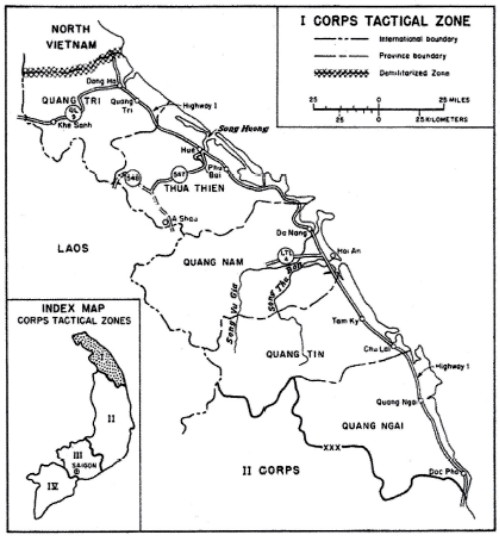
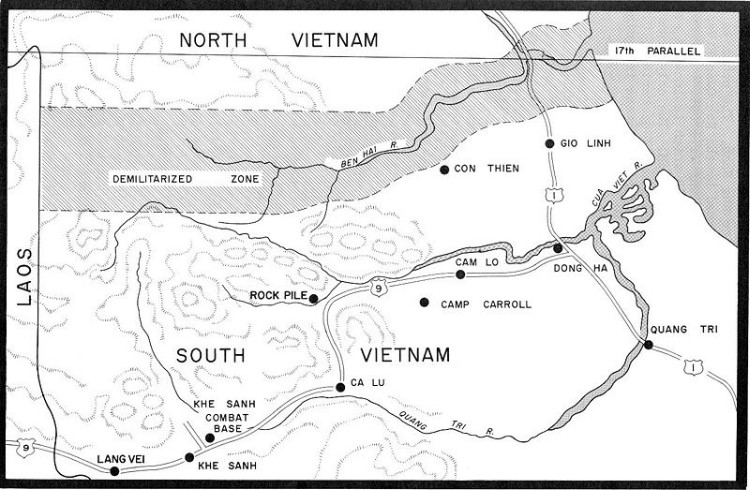
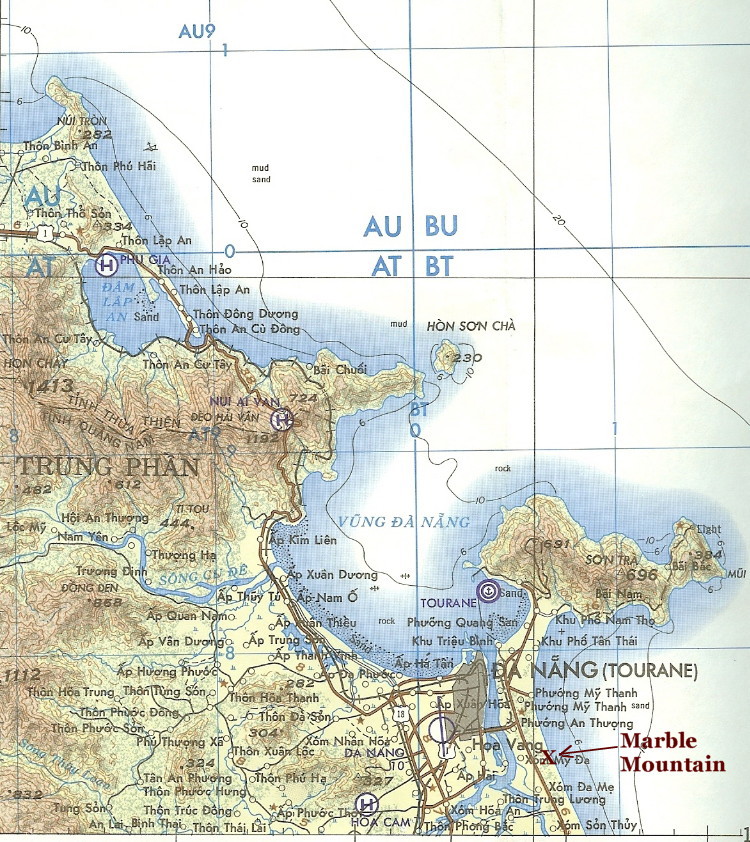
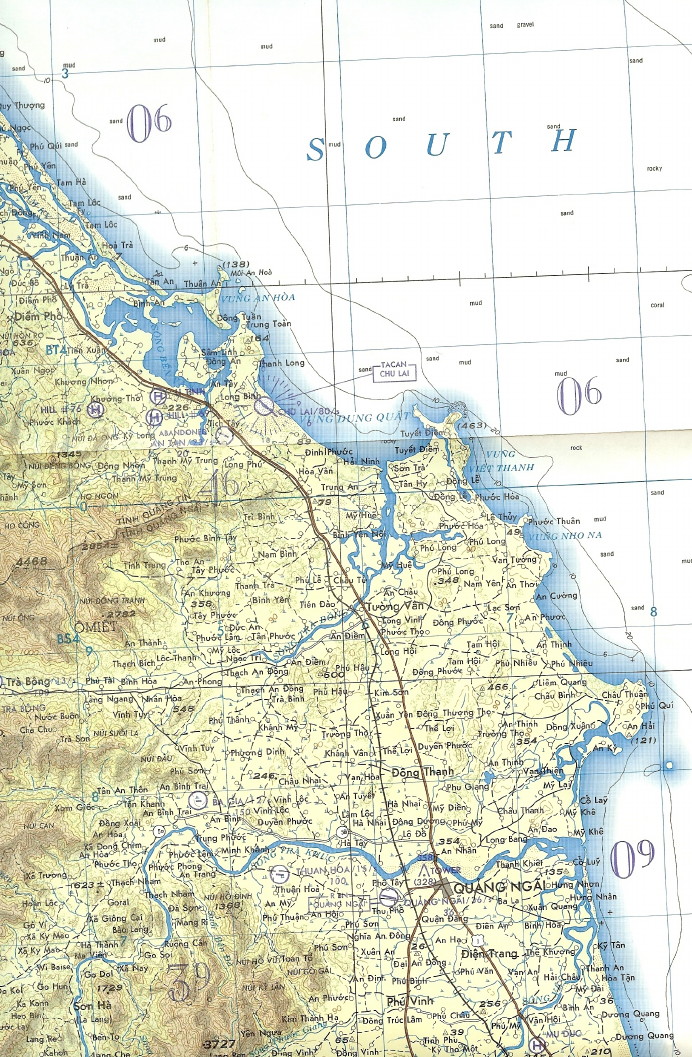
Other area maps from 1965 are available on a separate page. Click on this link to see maps for DMZ—Dong Hoi, Quang Tri—DMZ, Hue/Phu Bai—A Shau Valley, and DMZ—Laos.
In early September, GEN John K. Waters, CG US Army Pacific, visited the 220th. Upon his return to Hawaii, in a letter to the Company Commander, GEN Waters noted: "Your company area is one of the finest I have seen in Vietnam...."
On 10 September CPT Michael Pepe was shot down over the jungle near Kam Duc Special Forces Camp and was evacuated to CONUS — the first casualty/loss for the company. (I am waiting, and hoping, to get a more detailed story of this event.)
In mid-October, BG Richard J. Seitz, Deputy CG, USARV, visited:
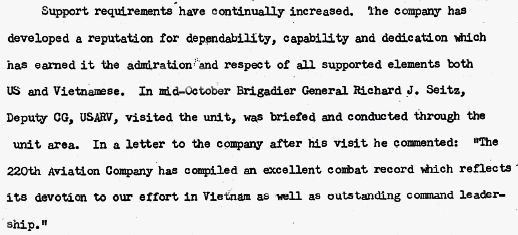
Although several of the company aircraft had taken bullet strikes and a few wounded warriors had earned Purple Hearts, the first losses were on 20 December 1965 when WO1 Ronald M. Fero and his observer, PFC Marvin Leroy, 1st Platoon, were KIA due to a mid-air collision with an ARVN aircraft over an ARVN combat operation near Quang Ngai. (Probably Operation "Harvest Moon")
At the close of Operation "Harvest Moon" in December, LTG Lewis W. Walt, Commanding General, III MAF, was highly complimentary in a message of appreciation to the 220th Aviation Company — "typical of support that Marines and ARVN forces in the I Corps Tactical Zone have received consistently in special as well as daily operations in the past" — a truly outstanding performance of duty.
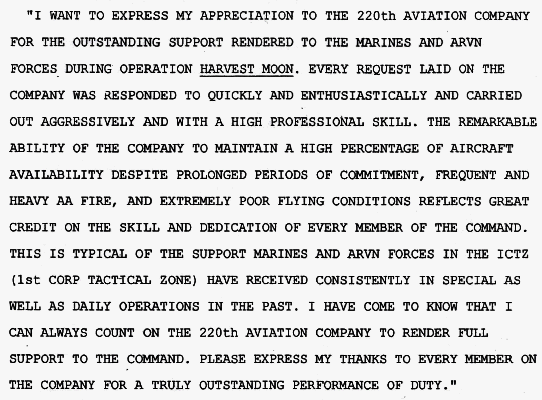
On 28 December all G-2 Air personnel from I Corps Headquarters, each Division Headquarters, and each Sector Headquarters assembled at the 220th Headquarters at Hue-Phu Bai where the entire day was spent in defining problems, discussing solutions, and refining and standardizing operations. The seminar was applauded as a complete success and considered to be not only worthwhile but necessary for coordinated support.
As the unit closed out its first six months in the Republic of Vietnam, between July and December there were 10,488 sorties flown for a total of 12,236 flying hours by the three platoons and the headquarters staff.
Note: For anyone interested in statistics, we also have monthly Aircraft Availability Rates, number of aircraft assigned and other information that could be charted.COMPILER: Gene Wilson




